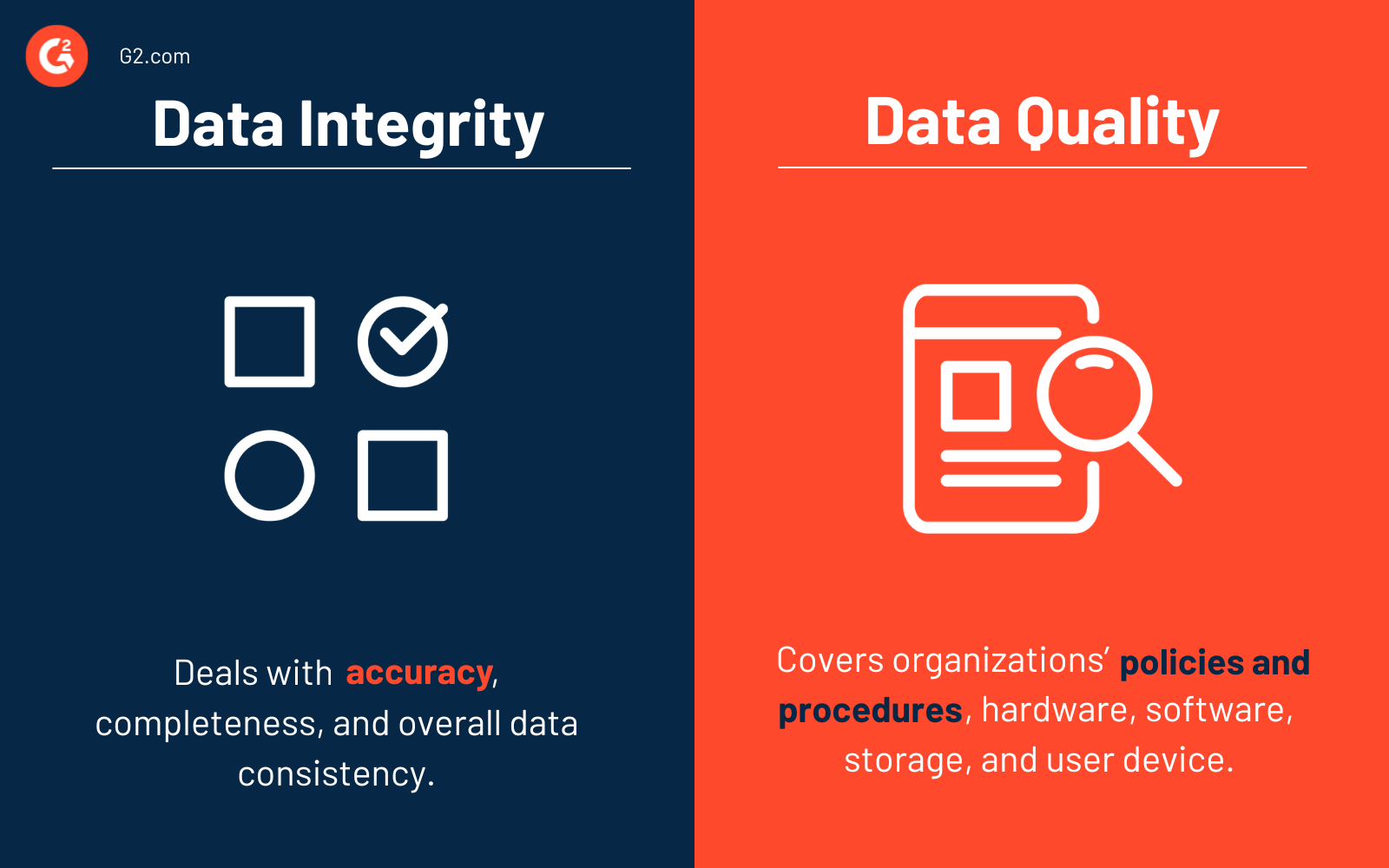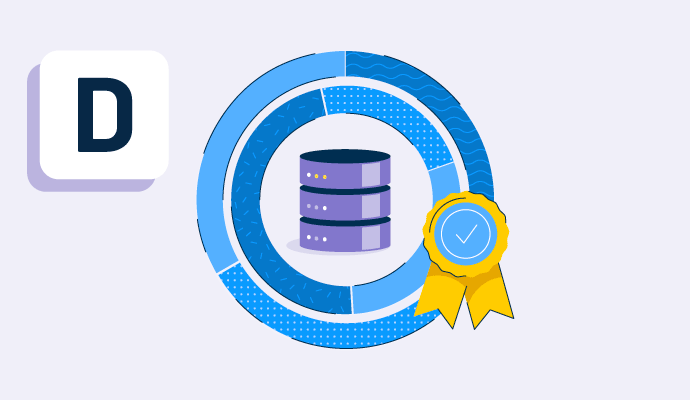What is data integrity?
Data integrity is the overall accuracy, completeness, and consistency of data in its lifecycle. It’s a critical aspect of designing, using, and implementing any system that stores or processes data.
Data health has become a pressing issue in this era of big data, where more information is processed and stored than ever before. As a result, taking steps to protect the integrity of the gathered data is non-negotiable. Data quality tools help a lot of businesses maintain the accuracy and consistency of data.
The first step in ensuring data security is comprehending the fundamentals of data integrity and how it functions. It’s impossible to overstate the significance of data integrity in preventing data loss or a data leak.
To keep one's data safe from malicious external forces, users must first ensure that internal users handle data appropriately. Users can prevent sensitive data from ever being misclassified or stored incorrectly by implementing the appropriate data validation and error checking.
Types of data integrity
Two main types of data integrity guarantee data consistency, accuracy, and completeness in relational and hierarchical databases.
- Physical integrity protects data's accuracy and completeness during storage and retrieval. Physical integrity is endangered when calamities occur. Human error and storage erosion can also be why data processing managers, system programmers, applications programmers, and internal auditors cannot obtain accurate data.
-
Logical integrity protects the integrity of the data in a relational database. Physical integrity shields data from human error and hackers, but logical integrity does so differently based on the following types.
- Entity integrity ensures data isn't listed duplicated and that no field in a table is null. They are the distinctive values that identify individual pieces of data.
- Referential integrity describes procedures that guarantee uniform data storage and use. Rules about using foreign keys are incorporated into the database's structure to ensure that only appropriate changes, additions, or deletions occur. Rules may include restrictions that prevent duplicate data entry, provide accurate data entry, and forbid irrelevant data entry.
- Domain integrity guarantees the precision of each data entry in a domain. A domain in this context refers to the range of acceptable values a column may contain. It may have restrictions and other controls restricting the format, nature, and volume of entered data.
- User-defined integrity refers to the guidelines and limitations users develop to meet their specific requirements.
Best practices to guarantee data integrity
Since the risk to data integrity has grown to be so harmful to businesses and information systems, several strategic measures have been developed to reduce the risks. However, since it would be impossible to eliminate all risks simultaneously, users need to combine several different tactics and tools.
- Ensure high-quality, complete, and accurate data: The pursuit of data integrity starts during the collection phase’s design. Ask if the information gathered using this method is correct. Is there a guarantee that no data will be lost if collected this way? Is the information from a dependable source? After creating the collection strategy, evaluate whether it performs as intended. If not, make necessary changes to its design and begin collecting again. Starting with uncorrupted data is much simpler than correcting inaccurate data later.
- Check for errors: One of the simplest ways to lose data integrity is through human error, but users can control this situation. In addition to double-checking the work, asking others to review it, and exercising caution, a few other tricks can aid in error detection. Users can keep track of every distinct point in a dataset by doing something as straightforward as shading every other row.
- Be alert to cybersecurity threats: When an employee clicks a link in an email or text message containing malware, the malware activates and begins to steal or damage the data. Hackers have numerous methods for accessing data, so being aware of them can help protect integrity.
- Explain the significance of data integrity: Inform others about the need to safeguard data accuracy, completeness, and quality and how to combat potential threats if many employees handle data.
- Create data backups: Data backups are essential. Based on needs, this can happen overnight or more frequently, and it’s possible to automate this procedure fully. When two copies of the data are kept, and they both start similarly, the likelihood that users will ever lose or compromise their data significantly decreases.
- Learn data science: Developing data science skills benefits an organization and not only for its data integrity knowledge. A user can also use it to positively affect the business. It also provides the flexibility to manage one's career much more efficiently.
Importance of data integrity
Data integrity is crucial for the sake of maintaining any business. The data's accuracy enables individuals to keep an unaltered and complete database with a continuous data flow. Massive amounts of data moving throughout businesses is undoubtedly fantastic, but it won't be useful if the data is of poor quality.
Data integrity guarantees the quality of the product or service. It ensures the security and privacy of clients – for example, medical patients and social media users.
Data integrity gives users more confidence to use online tools and applications, which promotes the growth of businesses in the digital economy. The end-to-end protection of data transmission over a medium is possible. Stored procedures make it simple to have total control over data access.
Data integrity vs. data quality
Data security and data integrity are related concepts essential to one another's accomplishment. Data integrity requires data security, which protects data from unauthorized access or corruption.

Data integrity deals with accuracy, completeness, and overall data consistency. In terms of security and legal compliance, such as GDPR compliance, data integrity also refers to data security. A set of procedures, guidelines, and standards put in place during the design stage are responsible for keeping it up to date. No matter how long it is kept or how frequently it is accessed, information stored in a database will remain accurate, complete, and trustworthy if the integrity of the data is secure.
The process of preserving digital information throughout its entire lifecycle to guard it against corruption, theft, or unauthorized access is known as data security. It covers everything, including organizations’ policies and procedures, hardware, software, storage, and user devices. Tools and technologies used in data security make it easier to see how a company uses its data.
Through techniques like data masking, encryption, and redaction of sensitive information, companies protect their data against cyber threats. Additionally, the process aids businesses in simplifying auditing procedures and adhering to data protection laws that are becoming stricter.
Learn more about encryption to maintain data integrity throughout its lifecycle effectively.

Sagar Joshi
Sagar Joshi is a former content marketing specialist at G2 in India. He is an engineer with a keen interest in data analytics and cybersecurity. He writes about topics related to them. You can find him reading books, learning a new language, or playing pool in his free time.





















